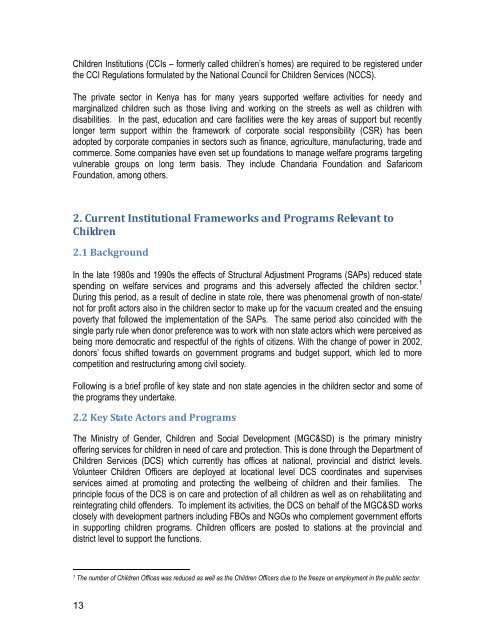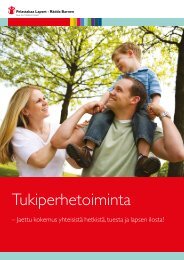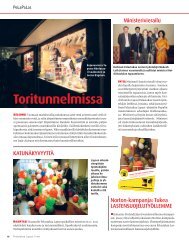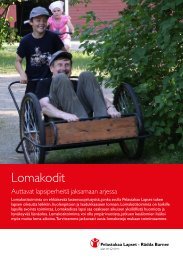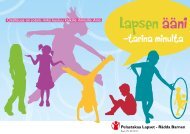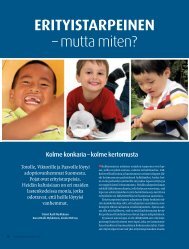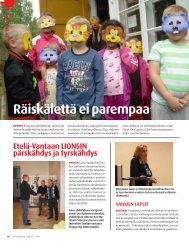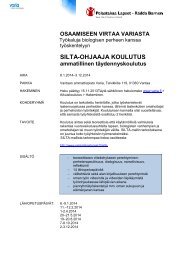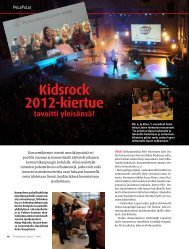Promoting child rights in Kenya - Pelastakaa Lapset ry
Promoting child rights in Kenya - Pelastakaa Lapset ry
Promoting child rights in Kenya - Pelastakaa Lapset ry
You also want an ePaper? Increase the reach of your titles
YUMPU automatically turns print PDFs into web optimized ePapers that Google loves.
Children Institutions (CCIs – formerly called <strong>child</strong>ren’s homes) are required to be registered underthe CCI Regulations formulated by the National Council for Children Services (NCCS).The private sector <strong>in</strong> <strong>Kenya</strong> has for many years supported welfare activities for needy andmarg<strong>in</strong>alized <strong>child</strong>ren such as those liv<strong>in</strong>g and work<strong>in</strong>g on the streets as well as <strong>child</strong>ren withdisabilities. In the past, education and care facilities were the key areas of support but recentlylonger term support with<strong>in</strong> the framework of corporate social responsibility (CSR) has beenadopted by corporate companies <strong>in</strong> sectors such as f<strong>in</strong>ance, agriculture, manufactur<strong>in</strong>g, trade andcommerce. Some companies have even set up foundations to manage welfare programs target<strong>in</strong>gvulnerable groups on long term basis. They <strong>in</strong>clude Chandaria Foundation and SafaricomFoundation, among others.2. Current Institutional Frameworks and Programs Relevant toChildren2.1 BackgroundIn the late 1980s and 1990s the effects of Structural Adjustment Programs (SAPs) reduced statespend<strong>in</strong>g on welfare services and programs and this adversely affected the <strong>child</strong>ren sector. 1Dur<strong>in</strong>g this period, as a result of decl<strong>in</strong>e <strong>in</strong> state role, there was phenomenal growth of non-state/not for profit actors also <strong>in</strong> the <strong>child</strong>ren sector to make up for the vacuum created and the ensu<strong>in</strong>gpoverty that followed the implementation of the SAPs. The same period also co<strong>in</strong>cided with thes<strong>in</strong>gle party rule when donor preference was to work with non state actors which were perceived asbe<strong>in</strong>g more democratic and respectful of the <strong>rights</strong> of citizens. With the change of power <strong>in</strong> 2002,donors’ focus shifted towards on government programs and budget support, which led to morecompetition and restructur<strong>in</strong>g among civil society.Follow<strong>in</strong>g is a brief profile of key state and non state agencies <strong>in</strong> the <strong>child</strong>ren sector and some ofthe programs they undertake.2.2 Key State Actors and ProgramsThe M<strong>in</strong>ist<strong>ry</strong> of Gender, Children and Social Development (MGC&SD) is the prima<strong>ry</strong> m<strong>in</strong>ist<strong>ry</strong>offer<strong>in</strong>g services for <strong>child</strong>ren <strong>in</strong> need of care and protection. This is done through the Department ofChildren Services (DCS) which currently has offices at national, prov<strong>in</strong>cial and district levels.Volunteer Children Officers are deployed at locational level DCS coord<strong>in</strong>ates and supervisesservices aimed at promot<strong>in</strong>g and protect<strong>in</strong>g the wellbe<strong>in</strong>g of <strong>child</strong>ren and their families. Thepr<strong>in</strong>ciple focus of the DCS is on care and protection of all <strong>child</strong>ren as well as on rehabilitat<strong>in</strong>g andre<strong>in</strong>tegrat<strong>in</strong>g <strong>child</strong> offenders. To implement its activities, the DCS on behalf of the MGC&SD worksclosely with development partners <strong>in</strong>clud<strong>in</strong>g FBOs and NGOs who complement government efforts<strong>in</strong> support<strong>in</strong>g <strong>child</strong>ren programs. Children officers are posted to stations at the prov<strong>in</strong>cial anddistrict level to support the functions.1The number of Children Offices was reduced as well as the Children Officers due to the freeze on employment <strong>in</strong> the public sector.13


